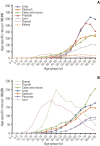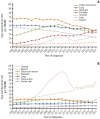Cancer Statistics in Korea: Incidence, Mortality, Survival, and Prevalence in 2021
- PMID: 38487832
- PMCID: PMC11016640
- DOI: 10.4143/crt.2024.253
Cancer Statistics in Korea: Incidence, Mortality, Survival, and Prevalence in 2021
Abstract
Purpose: The current study provides national cancer statistics and their secular trends in Korea, including incidence, mortality, survival, and prevalence in 2021.
Materials and methods: Incidence, survival, and prevalence rates of cancer were calculated using the Korea National Cancer Incidence Database, from 1999 to 2021, with survival follow-up until December 31, 2022. Deaths from cancer were assessed using causes-of-death data obtained from Statistics Korea.
Results: The number of new cancer diagnoses in 2021 increased by 27,002 cases (10.8%) compared to 2020. In 2021, newly diagnosed cancer cases and deaths from cancer were reported as 277,523 (age-standardized rate [ASR], 289.3 per 100,000) and 82,688 (ASR, 67.6 per 100,000), respectively. The overall cancer incidence rates increased by 3.3% annually from 1999 to 2012, and decreased by 5.3% from 2012 to 2015, thereafter, followed by non-significant changes. Cancer mortality rates have been decreasing since 2002, with more rapid decline in recent years (annual decrease of 2.8% from 2002 to 2013; 3.2% from 2013 to 2021). The 5-year relative survival between 2017 and 2021 was 72.1%, which contributed to prevalent cases reaching over 2.4 million in 2021.
Conclusion: In 2021, the number of newly diagnosed cancer patients increased as healthcare utilization recovered from the coronavirus disease 2019-related declines of 2020. Revised cancer registration guidelines expanded the registration scope, particularly for stomach and colorectal cancer. Survival rates have improved over the years, leading to a growing population of cancer survivors, necessitating a comprehensive cancer control strategy. The long-term impact of the pandemic on cancer statistics requires future investigation.
Keywords: Incidence; Korea; Mortality; Neoplasms; Prevalence; Survival.
Conflict of interest statement
Conflict of interest relevant to this article was not reported.
Figures







References
-
- Ferlay J, Ervik M, Lam F, Laversanne M, Colombet M, Mery L, et al. Global Cancer Observatory: Cancer Today [Internet] Lyon: International Agency for Research on Cancer; 2022 [cited 2024 Feb 14]. Available from: https://gco.iarc.who.int/today/
-
- Statistics Korea [Internet]. Daejeon: Statistics Korea; 2022 [cited 2024 Feb 14]. Available from: https://kosis.kr.
-
- Siegel RL, Miller KD, Wagle NS, Jemal A. Cancer statistics, 2023. CA Cancer J Clin. 2023;73:17–48. - PubMed
MeSH terms
LinkOut - more resources
Full Text Sources
Medical

